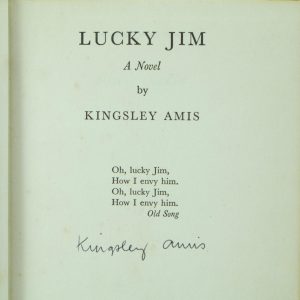What’s in the signature?
A question often asked about rare and first edition books. Of course the answer is not as straight forward as it might seem. To put it simply, the interest of a signature in a book depends on who it is and what else is included in the writing.
Of course the “who” goes without saying. It has to be the author or illustrator who is well known to add value to a book. And factor in whether the person is still alive or was a serial signer or not. For example, a signed Bram Stoker or Rudyard Kipling book is both of value due to the fact both are long deceased and both signed very few of their books.
Signatures of people associated with a book’s film adaptation have interest too, so a first edition Ian Fleming book signed by the Bond actor, whilst not worth as much as one signed by Fleming himself, would still add considerable value to the book. Even other actors who featured in the film add a degree of interest, with the likes of Honor Blackman (Pussy Galore from Goldfinger) leading the list.
In the book world there are so many sorts of signatures. And there seems to be a hierarchy of sorts among it all.
One level of the hierarchy is the signature written with nothing else and this can add interest to a book.  Kingsley Amis signed books are a good example. This simple signature of an author or illustrator maybe more valuable if it is dated and written directly on the pages of the book. Book plates or tipped in signatures are considered less desirable. Owners sometimes like to write their own name on a book and occasionally this can be of interest to a book collector if the person is on interest. Even a bookplate of a related and interesting character can add value to a book.
Kingsley Amis signed books are a good example. This simple signature of an author or illustrator maybe more valuable if it is dated and written directly on the pages of the book. Book plates or tipped in signatures are considered less desirable. Owners sometimes like to write their own name on a book and occasionally this can be of interest to a book collector if the person is on interest. Even a bookplate of a related and interesting character can add value to a book.
Nest step up in the ladder is the inscription signature. This is the signature which has been written especially for a particular person and naturally is especially interesting if that person is well known themselves. Of course a dedication inscription that is written to an unknown person may actually detract from a books value.
Any story behind a signature can add interest and value to a book and is called an association copy. This is where the author or illustrator’s signature is inscribed to someone associated with the writer. Links of association could be family members, other famous authors, politicians or anyone of note. Our ephemera within Now We Are Six depicting connections between H. G. Wells and A. A. Milne is a fascinating find. Occasionally the person who collects the books may become an association of interest. These can tell a story, delving into a piece of literary history so this will always add value and interest to any bibliophile. Finding a date alongside the writing may pin point the interest to a significant event.
A dedication signature is the ultimate level of signatures and can add significant value and attention to a bibliophile. Finding a signature dedicated to the person to whom the book was written for is quite special and rare to locate.
The worth of a signature will naturally be dependent slightly on market forces – the more generous an author is in signing their publication the less value the signature might have. Books of famous authors who rarely scribbled their names on their books are sought after items example. An author whose books are highly collectable will obviously attract more attention (usually if signed or not!).
For identification purposes the more that is written the better to confirm the authenticity of the writing and establishing the accuracy of the writer is best done through a specialist service to avoid costly mistakes.
Such a wealth of choices of signed books makes the bibliophile’s search for what’s in the signature of the next book such an interesting and enduring task.